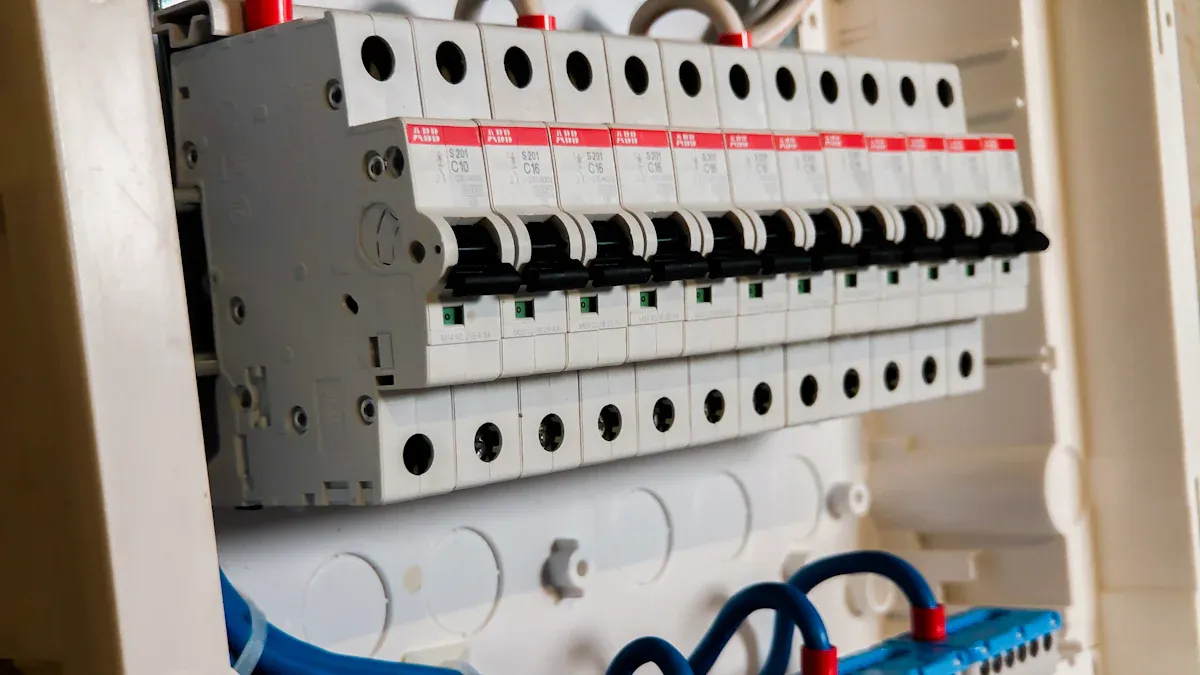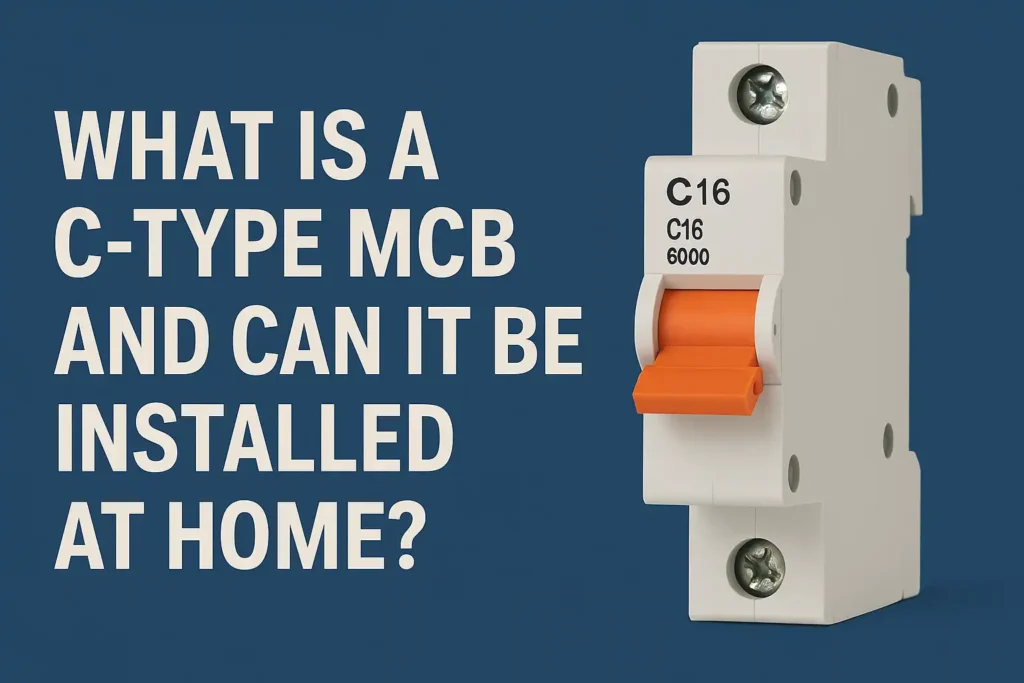A C-type MCB is a circuit breaker. It trips when the current is five to ten times higher than its normal value. You can use a C-type MCB at home. It is good if you have things like air conditioners or refrigerators. These appliances need a lot of power when they start. This device protects your wires from getting too much electricity or from short circuits. Picking the right circuit breaker keeps your home safe. It also helps your devices work well.
Key Takeaways
- A C-type MCB keeps home circuits safe by turning off power when the current is 5 to 10 times higher than normal. It can handle big power surges from things like air conditioners and refrigerators.
- This breaker uses heat and magnets to stop long overloads and sudden short circuits fast and safely.
- C-type MCBs are good for homes with motors or large appliances. B-type MCBs are better for lights and small devices. This helps stop the breaker from turning off when it should not.
- Always pick the right MCB for your home’s devices. Call a licensed electrician to install or replace it to keep your home safe.
- Using the right MCB stops power outages, protects your wires, and helps your appliances work well without getting damaged.
C-type MCB Overview
What Is a C-type MCB
A C-type MCB is a miniature circuit breaker that protects your home’s electrical circuits. You use it to stop too much current from flowing through your wires. This type of breaker trips, or shuts off, when the current reaches five to ten times its normal value. This feature makes it different from other types of MCBs. You often choose a C-type MCB for circuits that power devices with motors or parts that need a lot of energy to start. These devices can cause a quick surge of electricity, called an inrush current. The C-type MCB handles these surges without tripping too easily.
How It Works
You can think of a C-type MCB as having two main parts that sense trouble:
- Thermal Trip Mechanism: This part uses a bimetallic strip. When too much current flows for a long time, the strip heats up and bends. This bending action opens the circuit and stops the flow of electricity.
- Magnetic Trip Mechanism: This part acts very fast. If a short circuit happens, a strong magnetic field forms and pulls a switch to open the circuit right away.
Note: The C-type MCB trips at 5 to 10 times its rated current. It reacts quickly to short circuits and also protects against long-term overloads. You must reset it by hand after it trips.
Here is a table that shows how C-type MCBs compare to other types:
| MCB Type | Tripping Current Range (times full load current) | Operating Time Range |
|---|---|---|
| Type B | 3 to 5 | 0.04 to 13 seconds |
| Type C | 5 to 10 | 0.04 to 5 seconds |
| Type D | 10 to 20 | 0.04 to 3 seconds |
Typical Uses
You often find C-type MCBs in homes with appliances that need a lot of power when they start. These appliances include:
- Air conditioners
- Refrigerators
- Water heaters
- Microwaves
- Washing machines
- Vacuum cleaners
You may also see C-type MCBs in homes with smart devices or renewable energy systems, such as solar panels. As more people use advanced electronics and build new homes, the need for reliable circuit protection grows. C-type MCBs help keep your home safe by handling the extra demands of modern appliances.
C-type MCB vs. Other Types
B-type vs. C-type
You might ask how a B-type MCB is different from a C-type MCB. Both keep your home safe from electrical trouble, but they work best in different ways. B-type MCBs trip when the current is 2 to 3 times higher than normal. This makes them good for things like lights or toasters. These items do not make big power surges when turned on.
C-type MCBs trip at 5 to 10 times the rated current. They can handle bigger surges from things like motors or appliances that need a lot of power to start. If you have air conditioners or washing machines, you might need a C-type MCB.
Here is a table that shows how they are different:
| Feature | B-type MCB | C-type MCB |
|---|---|---|
| Trip current multiple | 2-3 times rated current | 5-10 times rated current |
| Typical trip time | Not specified | Must trip within 0.1 seconds |
| Common applications | Lights, small appliances | Appliances with motors, larger loads |
| Suitability in home use | Less common now | Most common type in homes |
| Inrush current handling | Lower tolerance | Higher tolerance |
| Performance implication | Good for sensitive circuits | Good for circuits with moderate surges |
Tip: If you have many devices that start with a surge, pick a C-type MCB.
D-type Comparison
D-type MCBs work in a different way than the others. They trip at 10 to 15 times the rated current. You usually see them in factories or places with big machines. These machines make very large surges when they start.
- D-type MCBs are not made for homes. They are best for places like factories, data centers, or solar farms.
- D-type MCBs can handle much higher currents and have a higher breaking capacity, up to 25kA.
- C-type MCBs are good for homes, offices, and small shops. They protect against medium surges and help keep your home safe.
Pros and Cons of Using C-type MCBs at Home
Pros:
- Works with most home appliances, even ones with motors.
- Stops nuisance tripping from normal surges.
- Keeps your home safe from overloads and short circuits.
Cons:
- May not trip fast enough for very sensitive electronics.
- Not needed if your home only has simple loads.
Note: Always pick the MCB type that fits your home’s needs. The right type helps protect your devices and wires.
Home Installation

When to Use C-type MCB
If you have big appliances at home, think about using a C-type MCB. These include air conditioners, refrigerators, water pumps, and some washing machines. When these start, they use a lot of power very quickly. This is called inrush current. If your breaker trips too easily, like a B-type, your power might go out for no real reason. This is called nuisance tripping.
Most homes with only lights and small appliances do best with B-type MCBs. These trip at lower currents and protect things like lamps and toasters. Use a C-type MCB only if your circuit has motors or compressors. These make higher inrush currents. This helps stop unwanted power cuts and keeps your home safe.
- B-type MCBs are good for lights and small electronics.
- C-type MCBs are better for motors or big appliances.
- Pick the breaker that matches what is on your circuit.
Safety Tips
Always be careful with your home’s electrical system. Before you work, turn off the main power. Never touch wires unless you know the power is off.
Here are some safety tips:
- Use the right size and type of MCB for your circuit.
- Check wires and connections for damage or heat.
- Do not plug in too many devices at once.
- Keep water away from your electrical panel.
- If you are not sure, call a licensed electrician.
⚠️ Tip: Do not try to install or change an MCB if you are not trained. Electricity can hurt you badly.
Replacement Advice
If you want to swap a B-type MCB for a C-type MCB, check what is plugged into the circuit. Look for motors, pumps, or things that use a lot of power when starting. A C-type MCB can help stop nuisance tripping. If you only have lights or small gadgets, keep using a B-type MCB.
Ask a qualified electrician to check your wiring and what your home needs. The electrician can measure inrush current and help you choose the right breaker. This keeps your home safe and your appliances working well.
🛠️ Note: The best MCB type depends on your appliances and how much current they use when starting. Getting help from a pro keeps your electrical system safe.
You now know how each MCB type is different for homes. Picking the right breaker helps keep your house safe. It also helps your appliances work well.
- MCBs stop too much current and short circuits.
- They last longer than fuses and fit in new panels.
- You need to pick the right breaker for your devices.
- MCBs do not stop earth leakage, so be extra careful in kitchens and bathrooms.
Always talk to a licensed electrician before you put in or change any breaker. For more home electrical safety tips, look at guides from the National Fire Protection Association or your local utility.
FAQ
What does “inrush current” mean?
Inrush current is the sudden surge of electricity that flows when you turn on a device, like a refrigerator or air conditioner. This surge can be much higher than normal running current. C-type MCBs handle these surges without tripping.
What happens if you use the wrong MCB type?
If you use the wrong MCB, you might get nuisance tripping or poor protection. For example, a B-type MCB may trip too often with big appliances. A C-type MCB may not protect sensitive electronics well.
What is the lifespan of a C-type MCB?
A C-type MCB usually lasts many years. You can expect it to work for over 10,000 operations if you use it correctly. Always check for signs of wear or damage.
What should you do if your MCB keeps tripping?
First, unplug all devices on the circuit. Try resetting the MCB. If it trips again, you may have a wiring problem or faulty appliance. You should call a licensed electrician for help.
What is the main difference between an MCB and a fuse?
A fuse melts and breaks the circuit once. You must replace it. An MCB trips and can be reset by hand. MCBs are safer and easier to use in modern homes.
The following information may be of interest to you
How to Match the Type of MCB to Your Electrical Load
MCB and MCCB Compared Which Circuit Breaker Is Right for You
The difference between miniature circuit breakers and fuses
Which type of MCB is most suitable for building wiring


KC6-KU-3-pole-circuit-breaker.webp)

